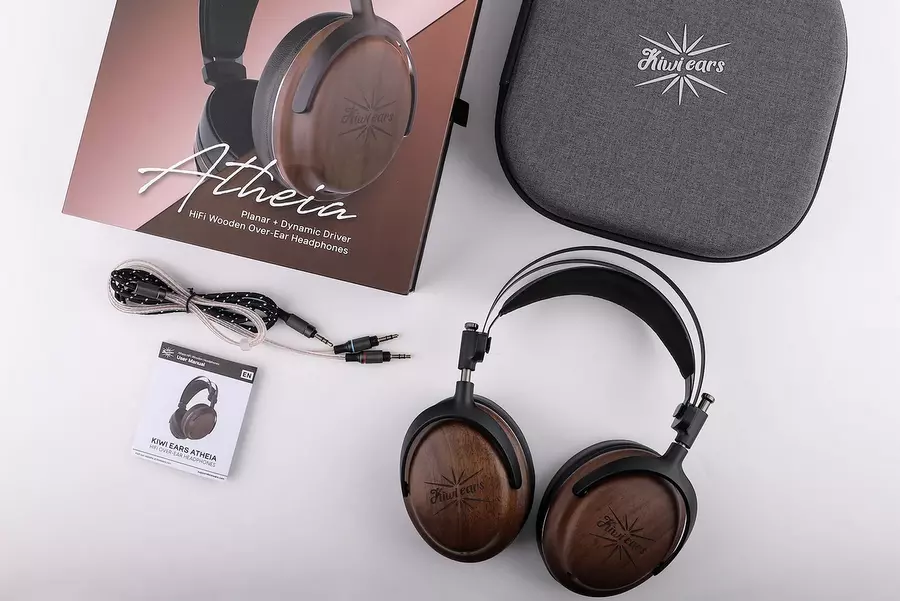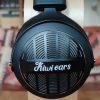Kiwi Ears has long made a name for itself in the in-ear monitor (IEM) arena, but now they’re stepping up their game with a bold push into full-size over-ear headphones. With five new models launched in rapid succession, Kiwi Ears is aiming to carve out space in a fiercely competitive market dominated by established heavyweights like Sennheiser, Grado Labs, Beyerdynamic, and even HiFiMAN. After reviewing the budget-friendly Ellipse, today we turn our attention to the $349 Atheia closed-back, hybrid-driver headphone that promises premium materials and standout tech. But with such tough competition, does the Atheia have what it takes to truly impress? Read on to find out.
Kiwi Ears Atheia Technology: A Hybrid Duo That Packs a Punch
Inside each cup of the Kiwi Ears Atheia lurk not one, but two drivers working in tandem. The main muscle is a hefty 50mm dynamic driver doing the heavy lifting, while perched on top of its center is a nimble 14.5mm planar magnetic driver — a combo that’s as uncommon as it is intriguing in the full-size headphone world. This hybrid setup aims to blend the punch and depth of dynamics with the speed and clarity of planar magnets, promising a sonic experience that’s anything but ordinary.
Both drivers in the Kiwi Ears Atheia share significant frequency overlap. Unlike the HiFiMAN Isvarna, which employs a crossover to separate the ranges. Here, the dynamic driver primarily handles the punchy bass, while the planar magnetic driver focuses on delivering clear, detailed highs.
Together, they produce a Total Harmonic Distortion (THD) of 0.5% at 1mW. While Kiwi Ears touts this figure as a key selling point, it’s actually fairly average compared to other headphones in this class, offering decent but not outstanding distortion performance.

Design & Comfort: Kiwi Ears Atheia Impresses with Premium Build and Wearability
The Kiwi Ears Atheia arrives with a semi-rigid carry case that earns bonus points for its slim profile, making it easy to slip into a backpack for on-the-go use. Inside the box, you’ll find a detachable 3.5mm cable and the usual user manual.
The included cable is lightweight, an ideal length at 150cm, and exhibits very low microphonics. However, it holds its shape stubbornly, and the silicone coating above the splitter feels a bit out of place. Plus, no quarter-inch adapter which is an odd omission at this price point.
If you want to upgrade the cable, be warned: the recessed cable entries in the earcups restrict compatibility, limiting your choice of aftermarket cables.
As for the headphones themselves, the build quality is outstanding. Walnut wood earcups, plush vegan leather earpads, a suede-finish suspension headband, and metal fixtures all combine to give a premium feel that rivals far more expensive models.
Despite the luxury materials, the Atheia remains lightweight at under 350 grams. Paired with soft earpads and a gentle clamp force, these headphones are comfortable enough for marathon listening sessions.
Bonus: the wooden cups do a solid job blocking out external noise—so no one will overhear your guilty pleasure playlists.

Listening: Atheia Aims for Neutral, Lands Somewhere Else
Kiwi Ears claim that the Atheia delivers a “balanced, neutral sound profile.” That might look good on a spec sheet, but to my ears, it’s not even close.
What I actually heard was a dark-leaning signature with elevated bass and a laid-back treble response. Plenty of thump on the low end, but with some tonal quirks that keep it from being a smooth, reference-grade experience. The bass is certainly fun, but there are balance issues in the mids and highs that got in the way of full musical immersion.
For these listening impressions, I tested the Atheia with a range of sources: the Burson Conductor GT4 DAC/Amp, JDS Labs Element IV DAC/Amp, and the iBasso DX340 DAP. I also plugged them directly into my laptop’s headphone jack to check drivability.
The DAC/amps connected via USB handled a mix of Spotify streams and hi-res FLAC files, providing a good variety of content for evaluation.
Bass: Atheia Brings the Boom, But Not the Nuance
Let’s get one thing straight: the Kiwi Ears Atheia does not lack bass. If anything, it delivers a downright aggressive helping of it, especially in the mid-bass region. For a closed-back headphone, the Atheia leans surprisingly heavy on the thump rather than the rumble, with the subbass noticeably trailing off.
The result? A bassline that hits hard but feels one-dimensional. For example, Daft Punk’s “Doin’ it Right” turned into a mid-bass assault that forced me to dial down the volume. That, in turn, buried the finer details in the mix and dulled the overall experience.
There’s no denying the Atheia can kick. It delivers serious impact that could satisfy EDM or hip-hop fans looking to replicate the club experience at home. But for those who crave texture, layering, and that deep subbass growl, the Atheia’s low-end performance comes up short.
By comparison, something like the Denon AH-D5200 closed-back headphone in the same price ballpark manages a more controlled and extended bass response, while offering slam and finesse.
Midrange: Where the Atheia Stumbles the Most
If the bass punches hard, the midrange on the Kiwi Ears Atheia takes a hit, and not in a good way. As the frequency response transitions from the bass to the mids, there’s a noticeable dip in the lower midrange that robs vocals of their presence and weight.
Listening to “Still D.R.E.” by Dr. Dre and Snoop Dogg, the problem was immediate: the vocals sounded distant and smothered under the bass-heavy low end. You can feel the rhythm, but the verses lose impact because they’re buried so deep in the mix.
Then you swing up into the upper mids and get the opposite issue. Here, the tuning overshoots neutrality, giving female vocals and instruments like electric guitar an occasional harshness—especially on less-than-perfect recordings. A track that should sound emotive can instead come across as edgy or shouty, with sibilance creeping in at higher volumes.
The imbalance between the scooped-out lower mids and the spiky upper mids makes the Atheia a tough sell for vocal-centric genres, where clarity and natural tonality matter most. It’s not unlistenable, but it sure isn’t refined.
Treble: Smooth Sailing… Until It Isn’t
At first blush, the treble on the Kiwi Ears Atheia seems fairly laid-back, especially when compared to its booming bass. This relaxed tuning helps avoid the brittle, splashy highs that some hybrid headphones fall into. But dig a little deeper, and a few sharp edges start to poke through.
There’s an odd peak somewhere in the 6 to 8kHz range (at least on my head) that creates a bit of a Jekyll and Hyde situation. While the treble isn’t overly emphasized overall, this specific spike causes unexpected bursts of sharpness — like the hi-hats in L’Impératrice’s “La Lune”, which crossed the line from crisp into piercing. And the longer I listened, the more fatiguing it became, especially at moderate-to-high volumes.
That said, the Atheia does have moments where its technical chops shine through. That same track features a subtle triangle hit tucked deep in the mix, and the Atheia brought it forward with surprising clarity. It’s a small detail, but one that reveals the headphone’s potential when the tuning isn’t getting in its own way.
So while the treble isn’t a complete dealbreaker, it’s more of a “handle with care” situation. You’ll get decent detail, but the occasional jab to the ears could leave you reaching for something smoother.
Soundstage & Imaging: Wider Than Expected, but Not Quite Laser-Sharp
The Kiwi Ears Atheia pulls a bit of a rabbit out of its hat when it comes to soundstage. For a closed-back design, the sense of space is genuinely surprising—wider than average and even edging out the Denon AH-D5200 in sheer lateral spread. You’re not getting the open-field experience of a planar open-back, but for something that seals you off from the world, it’s impressively expansive.
Imaging, however, doesn’t quite stick the landing. While the Atheia offers a solid center image that’s useful for anchoring vocals and lead instruments, some spatial definition falls flat. Instrument placement lacks precision, with sounds occasionally smearing together in the same space when they should clearly occupy distinct points in the mix. It doesn’t collapse into chaos, but if you’re into pinpoint imaging for orchestral work or competitive gaming, you’ll notice the blur.
Despite that, there’s a decent sense of depth and layering. It feels more like watching a good stage play than a surround-sound blockbuster. But for this price and form factor, that’s not a bad result.

Drivability: No Power Trip Required
With a 32Ω impedance and a sensitivity of 102dB/mW, the Kiwi Ears Atheia is a breeze to drive. Plugging straight into the 3.5mm output of a laptop gave me more than enough volume to hit my sweet spot (about 65–70dB) with headroom to spare. This makes the Atheia a friendly option for casual listeners who don’t want to fuss with external gear.
That said, when paired with a proper DAC/Amp like the JDS Labs Element IV (which we recently reviewed), there was a modest, but audible improvement in dynamics and control. Switching over to more serious gear like the iBasso DX340 DAP and the Burson Conductor GT4 revealed only subtle changes, reinforcing that this headphone doesn’t scale dramatically with better equipment.
Bottom line? You don’t need a desktop rig to enjoy the Atheia. A quality dongle DAC like the iFi GO link Max will unlock most of what it has to offer — no sweat, no fuss, no fire hazards.
The Bottom Line: Beauty Meets Bloat
The Kiwi Ears Atheia is an undeniable looker. With its walnut wood earcups, sturdy metal hardware, and plush vegan leather padding, it feels far more luxurious than its $349 price suggests. Comfort is top-notch, and the build rivals headphones at double the price.
But looks aren’t everything. Sonically, the Atheia stumbles hard. The bloated mid-bass and recessed mids undermine its claim of a “balanced, neutral” sound signature. Add in a touchy treble peak and it becomes clear: this isn’t the refined hybrid performance you might expect from a company with IEM experience.
Strangely enough, I found myself enjoying the far cheaper Kiwi Ears Ellipse more. That sub-$100 open-back felt like a more coherent and enjoyable listen, despite its limitations. The Atheia might be dressed to impress, but in the world of audio, it’s what’s inside that counts. And in this case, the sound just doesn’t match the suit.
Pros:
- Looks and feels far more premium than the $349 price tag suggests
- Exceptionally comfortable for long listening sessions
- Bass-heavy tuning will appeal to EDM and hip-hop fans craving punch
Cons:
- Treble spike can cause fatigue over extended listening sessions
- Included cable is lightweight but awkward and lacks a 1/4″ adapter
- Bloated mid-bass overwhelms the mix and muddies vocals
Where to buy:
Related Reading:
- Focal Azurys Review: Fancy French Closed-Back Headphones That Toss Bass Like A Paris Café Argument
- Meze Audio POET Headphones Review: The Right Blend Of Sound And Portability?
- Beyerdynamic DT 1770 Pro MKII Review: Refined And Affordable For Studio Work
- Stax SR-X1 Earspeaker Review: Can A $535 Electrostatic Headphone Convince The Naysayers?
























